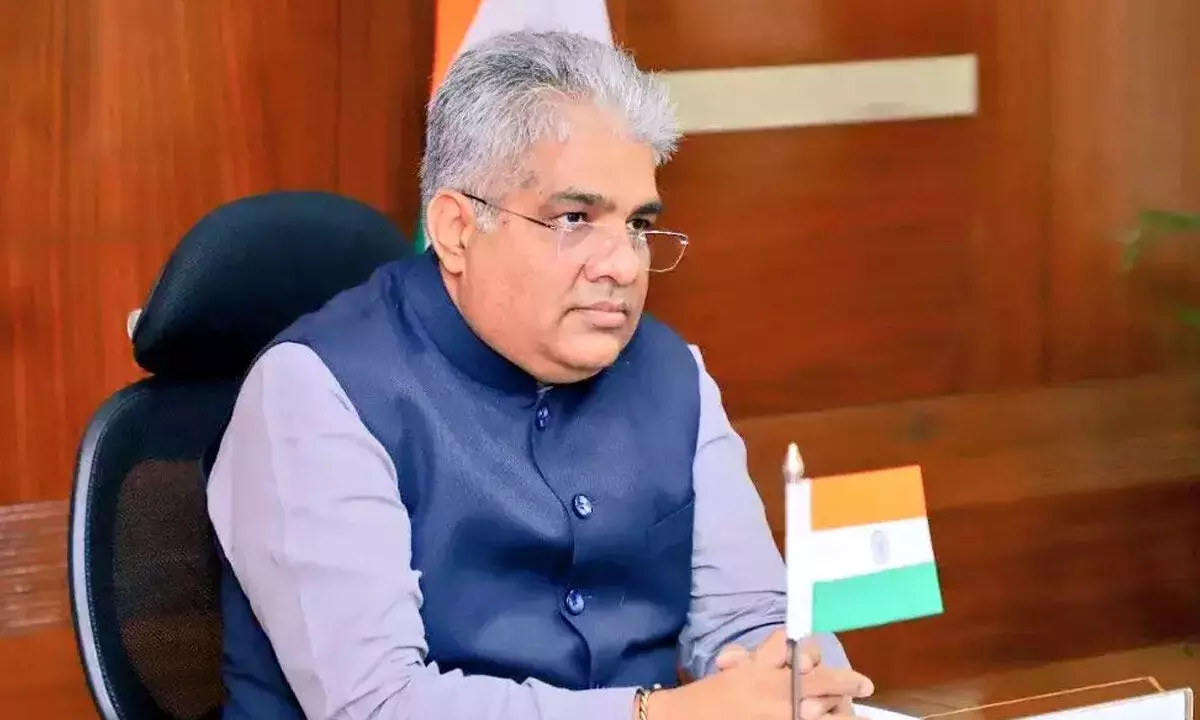Live
- Seven-day national mourning in respect of Dr. Manmohan Singh
- 'I've lost a mentor and guide': Rahul Gandhi grieves demise of Dr. Manmohan Singh
- 'Great loss for all of us': President Droupadi Murmu mourns Manmohan Singh's demise
- Dr Singh presented milestone budget of 1991 which liberalised Indian economy: FM Sitharaman
- PM Modi condoles demise of Dr. Manmohan Singh
- Former Prime Minister Manmohan Singh Dies at 92: A Legacy of Economic Reforms
- Nagesh Trophy: Telangana, Gujarat dominate action on Day 4 with easy wins
- Get Ready for Dreame Technology’s Year-End Amazon Sale – Big Savings on Smart Home Products
- FIR registered as 4 voter forgery cases come to light in Delhi's Okhla constituency
- Ayodhya Ram temple to host majestic anniversary celebrations on Jan 11 with devotional, cultural programmes
Just In
AAP govt's 'criminal failure' to provide alternatives to farmers in Punjab has turned Delhi into gas chamber: Bhupender Yadav

Union Environment Minister Bhupender Yadav on Thursday alleged the AAP government's "criminal failure" to provide alternatives to farmers in Punjab has "turned Delhi into a gas chamber".
New Delhi: Union Environment Minister Bhupender Yadav on Thursday alleged the AAP government's "criminal failure" to provide alternatives to farmers in Punjab has "turned Delhi into a gas chamber".
"This country is yet to see a bigger liar than Arvind Kejriwal. 93 percent of farm fire events this year have happened in Punjab, turning Delhi-NCR into a gas chamber, because Aam Aadmi Party has failed to provide alternatives to farmers. This is a criminal failure of governance on the part of AAP," Yadav posted on X. According to data from the Decision Support System, a numerical model-based framework capable of identifying sources of particulate matter pollution in Delhi, stubble burning in neighbouring states, especially Punjab and Haryana, accounted for 37 per cent of the air pollution in Delhi on Tuesday.
Delhi has recorded "severe" air quality on 6 days since November 3, with smoke from farm fires, especially in Punjab, being a major contributor to the capital's air pollution. The air quality in Delhi on Thursday too was in the 'severe' category and monitoring agencies predict no significant relief in the next five to six days. The city's 24-hour average Air Quality Index (AQI), recorded at 4 pm everyday, stood 437 on Thursday, worsening from 426 on Wednesday.
The AQI map prepared by the Central Pollution Control Board showed clusters of red dots (indicating hazardous air quality) spread across the Indo-Gangetic plains. According to the Indian Agricultural Research Institute, Punjab, which accounts for the maximum number of cases of stubble burning every year, reported 49,922 farm fires in 2022, compared to 71,304 the previous year and 83,002 in 2020. The agrarian state logged 50,738 incidents of stubble burning in 2019, 59,684 in 2018, 67,079 in 2017, and 102,379 in 2016. Haryana recorded 3,661 farm fires in 2022, down from 6,987 in 2021 and 4,202 in 2020. The neighbouring state witnessed 6,364 incidents of stubble burning in 2019, 9,225 in 2018, 13,085 in 2017, and 15,686 in 2016.
The Commission for Air Quality Management (CAQM), a statutory body responsible for formulating strategies to reduce pollution in Delhi-NCR, reported that the number of stubble burning incidents in Punjab and Haryana since September 15 has reduced by around 56 percent and 40 percent, respectively, compared to the corresponding period last year. The Punjab government aims to reduce farm fires by 50 per cent this winter season and eliminate stubble burning in six districts. According to the state's action plan to curb paddy straw burning, about 31 lakh hectares of land in the state are under paddy cultivation, expected to generate around 16 million tonnes of paddy straw (non-basmati).
Haryana estimates that about 14.82 lakh hectares of land in the state are under paddy cultivation, expected to generate over 7.3 million tonnes of paddy straw (non-basmati). The state is making efforts to nearly eliminate farm fires this year. Unfavourable meteorological conditions, combined with vehicular emissions, paddy straw burning, firecrackers and other local pollution sources contribute to hazardous air quality levels in Delhi-NCR during the winter every year. According to a DPCC analysis, the capital experiences peak pollution from November 1 to November 15 when the number of stubble burning incidents in Punjab and Haryana increases. Air quality in Delhi-NCR declined over the last two weeks due to a gradual drop in temperatures, calm winds that trap pollution and a surge in paddy straw burning across Punjab and Haryana. Delhi's air quality ranks among the worst in the world's capital cities

© 2024 Hyderabad Media House Limited/The Hans India. All rights reserved. Powered by hocalwire.com






